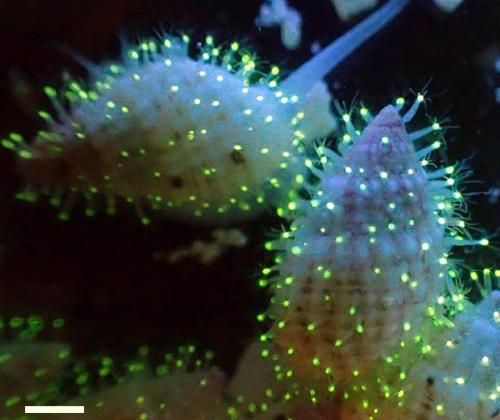The Red Sea is known as one of the best tourist destinations for good relaxation and scuba-diving, but no one can even imagine that this place is inhabited by many sea creatures that are still waiting to be discovered. An international team of biologists, which included researchers from the Lomonosov Moscow State University and the Shemyakin-Ovchinnikov Institute of Bioorganic Chemistry of the Russian Academy of Sciences, found and explored a new kind of beautiful luminous creatures. For the first time they showed that the localization of glow in certain parts of the body can help to distinguish different species of organisms that have identical structure. The collections of the MSU have been enlarged by these new fauna species and their DNA. The results of the study are published in PLOS ONE.
Mollusca decorated with Christmas lights
During the investigations of the biodiversity of coral reefs of the archipelago Farasan (Saudi Arabia, south of the Red Sea), biologists observed marine life under the UV-light with yellow filters. As a result they found "fluorescent lanterns", that were very similar to hydrae from the Biology school textbooks. But unlike their distant relatives who lead a solitary life in fresh water new species from the Red Sea form spreading colonies decorating miniature shells of gastropods Nassarius margaritifer (20-35 mm in length) with garlands of green lights. These molluscs bury themselves in the sediment during the day and at night crawl out to the surface to hunt other invertebrates.
 An international team of biologists including researchers from the Moscow State University discovered new species of fluorescent polyps living in colonies on the shells of gastropods. Credit: Viatcheslav N. Ivanenko et al.
An international team of biologists including researchers from the Moscow State University discovered new species of fluorescent polyps living in colonies on the shells of gastropods. Credit: Viatcheslav N. Ivanenko et al.
"Sea hydroids, unlike hydrae, are often found in colonies and canbranch off tiny jellyfish", -- says Vyacheslav Ivanenko, one of the authors of the research, the leading researcher of the Department of Invertebrate Zoology of the Lomonosov Moscow State University. "The unusual green glow of these hydrozoas (presumably, a new species of the genus Cytaeis, whose body length reaches 1.5 mm) was revealed in the peristomal area of the body".
Such unusual symbioses are poorly studied, and the role of the glow has not been investigated yet at all. The zoologists suggest that glow around the mouth of polyps may attract prey. "Fluorescent flashlights" may be visible to other invertebrates in the moonlight, and at sunset and sunrise. The discovery raises new questions. It has yet to find out how much these polyps are "fussy" choosing their host, how the activity of Nassarius snails and luminous hydroids change during the day, and how the fluorescence varies within species and between closely related species of hydrozoa.
The green glow of the Nobel Prize
Fluorescence is a glow of some proteins or pigments under light illumination, fading instantly after the end of the illumination. Fluorescent proteins are widespread among the corals Anthozoa and hydroid jellyfishes, and also were found in some lancelets (Cephalochordata) and combjellies (Ctenophora).The scientist Osama Shimomura was the first who isolated the famous green fluorescent protein (GFP) from the jellyfish Aequorea victoria that was later widely used in experimental biology as a glowing marker for the study of protein work in cells. In 2008, the Nobel Prize in Chemistry was awarded to Osama Shimomura, Martin Chalfie and Roger Tsien "for the discovery and development of the green fluorescent protein, GFP".
According to zoologists, the fluorescence of hydrozoa is studied only in case of six species, in some cases -- even at the early stages of development (eggs or jellyfishes before their attachment to the substrate). The fluorescence of some of them is localized on the tentacles or stalk, and not around the mouth, or shifted to another part of the spectrum. The maximum of fluorescence emission of the new species of the genus Cytaeis is at 518 nm.
"The comparison of the fluorescence of hydroid found in the Red Sea to those of other hydroids of the same genus, analysis of nuclear and mitochondrial DNA of the hydroid and evaluation of the data presented in the gene bank allowed to reveal the species-specific fluorescence of morphologically indistinguishable species of Cytaeis. Thus, using hydroids as an example, the researchers first demonstrated the ability to use peculiarities of the localization of the fluorescence for discrimination of similar invertebrates. The fluorescence can be useful for quick identification of hardly recognizable species and for the studies of ecological peculiarities and distribution of hydroids and their hosts -- molluscs", -- says Vyacheslav Ivanenko.
So close to wonders
According to Vyacheslav Ivanenko who discovered unusual polyps, a great number of new species with unusual features are still waiting for the researchers in the shallow waters of seas, accessible with scuba gear, including Russia.
source: Lomonosov Moscow State University